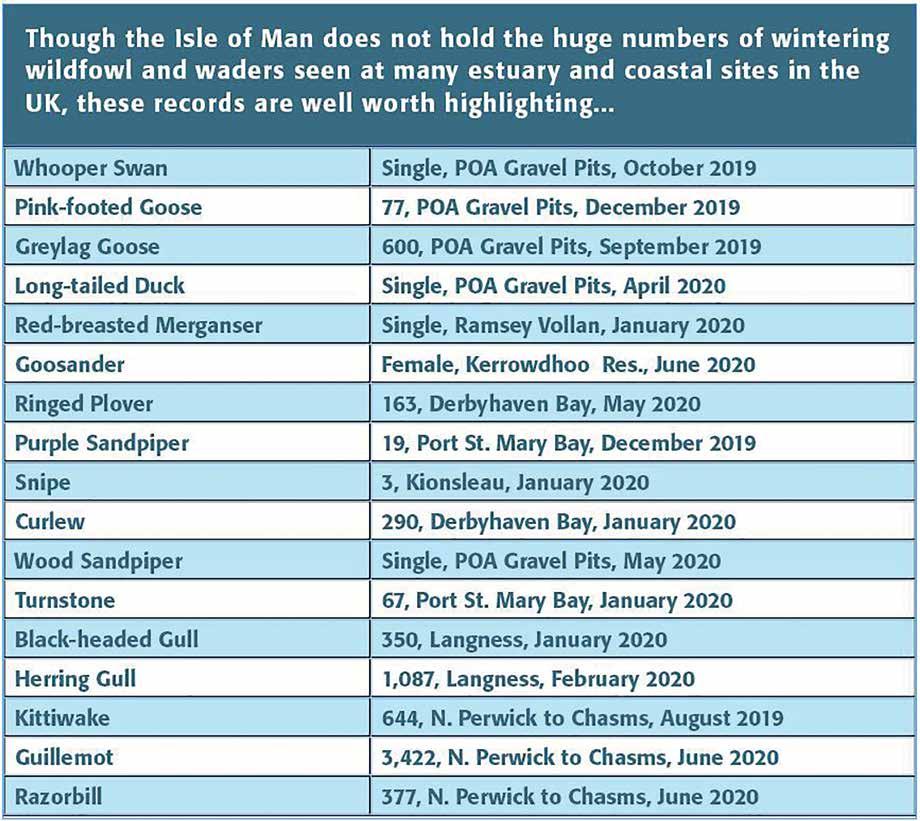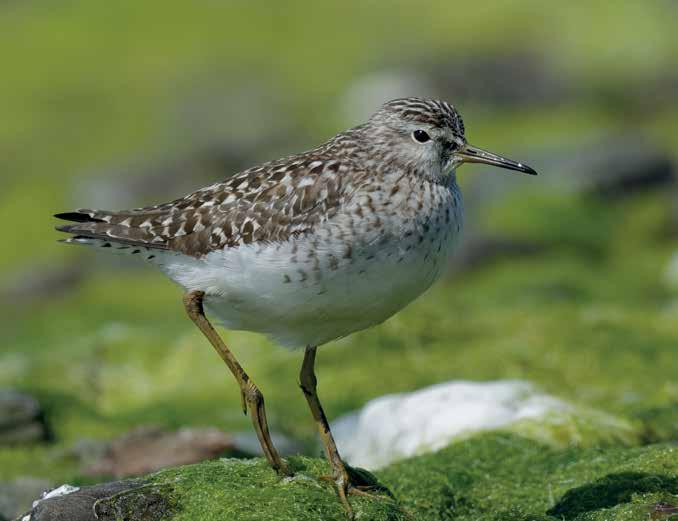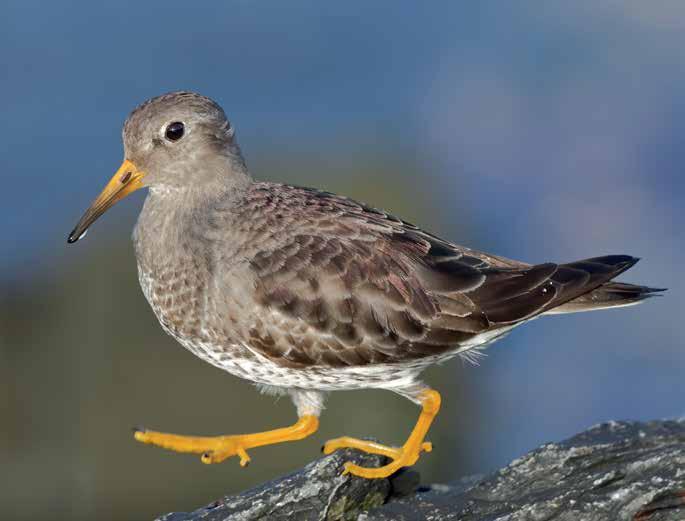
5 minute read
WeBS ON THE ISLE OF MAN
Manx WeBS counts on the up
Taking over as Local Organiser may seem a daunting challenge, but the rewards are well worth it, and often it brings with it new faces among the counters.
David Kennett WeBS Local Organiser
Itook over as WeBS Local Organiser (LO) from Pat Cullen in September 2019. For several decades, Pat carried out WeBS counts at most of the 50-or so sites originally assigned to the Isle of Man. Many of the records go back to the 1960s and 1970s, long before the current set-up was established and the online system introduced; some sites haven’t been surveyed for several years. Though retired as WeBS LO, Pat kindly agreed to again carry out Whooper Swan counts in January this year, as part of the five-yearly International Swan Census - as he put it, he had been counting Whoopers for over 40 years and was very familiar with their preferred winter haunts!
In July 2019, at the start of the WeBS reporting year, only six sites were being regularly counted. In the south, one volunteer who, encouraged to sign up to WeBS after an inspiring talk by Dawn Balmer at a Manx Ornithological Society (MOS) meeting in early 2017, took on not one, but four sites in the Port St Mary area! Further along the south coast, the North Perwick Bay to The Chasms site was added; this had been covered since April 2019 by the new counter who had previous WeBS experience at a site in the Forth Estuary in Scotland. In the north of the Island, coverage continued at the important Point of Ayre (POA) Gravel Pits site
(now part of a major new nature reserve) by the same counter who has been recording there every month for the past 20 years.
Following a few emails and some WeBS promotion at MOS winter meetings (many thanks to our bird club secretary and BTO Ambassador, Janet Thompson, for her encouragement and help), there was some very welcome interest in the survey. The Isle of Man is lucky in that the whole island is covered by a single OS 1:50,000 map (sheet 95) which (in addition to the WeBS Vacant Sites online page) makes it quite easy to display and show the vacant sites in a local context. In January 2020, six more sites were adopted: the important and demanding, but often disturbed, areas of Derbyhaven Bay and Langness (Castletown Bay East); the inland sites of Kionslieau and Eairy Dams by another new recruit (already a BBS volunteer); and in the north, Glascoe Dub (dub is Manx for a pond or small water body) and Ramsey Vollan (possibly better known locally as Mooragh Park Lake) by a fourth new counter who was already very familiar with both sites. And more were to come!
In April this year, two more counters (with previous WeBS experience at sites on Anglesey) took on, not only the existing site at Garwick Bay, but also created two new sites, the adjacent Laxey Bay (including the harbour) and a nearby farmland dub. In June, the seemingly unstoppable volunteer, already counting at the Glascoe and Ramsey Vollan sites, adopted


Single Wood Sandpiper, Long-tailed Duck and Red-breasted Merganser were some of the highlights of the 2019/20 WeBS Year on the Isle of Man, while Purple Sandpiper numbers peaked at 19 birds.


Ramsey Harbour (last surveyed about ten years ago) and finally, another new counter (and the second BBS volunteer to sign up to WeBS), took on the Clypse and Kerrowdhoo reservoir sites.
At times, throughout all this activity, I have felt a bit of a fraud, as although I’m familiar with many of these sites, I have yet to do a WeBS count myself. As LO, of course, I can visit the sites to do single visit counts and hopefully I may eventually get round to doing this.
Despite the restrictions due to the Coronavirus crisis, the vagaries of the weather and more than half the sites being covered for only 6 months, or less, the 2019/20 season saw 10 counters make a combined total of 96 visits to 17 separate coastal and inland sites, recording 69 different species. Of these, 40 were “core” wetland species, including wildfowl, waders, rails, grebes and cormorants, plus gulls and terns, while the remaining 29 are on the additional species lists, and included seabirds (e.g. the cliff nesting species), raptors, corvids and numerous small passerines. All the records have been interesting, whether from the big sites at Langness/Derbyhaven and the POA gravel pits, to the small Dubs with only a few ducks and Moorhens as the reward.
As very much a novice, still in my first year as LO, this has all definitely been a very steep learning curve but has been made much easier by the huge amount of help and advice I’ve received from the Counter Network Organiser, Gill Birtles, and of course, by the refreshed and very user-friendly, version of WeBS Online. The new 2020/21 season is already off to a good start with our latest counter (previous WeBS experience at sites in Chichester Harbour), taking on Douglas Harbour and Bay. This is a very welcome addition which will bring the total number of sites covered up to 18.
I think it’s been a remarkable year for WeBS in the Isle of Man, despite the difficulties of the last five months. It just remains for me to say a very big thank you to all the counters for their determination and hard work, and to the photographers who kindly allowed me to use their pictures in this article. I hope they will all be pleased to see their efforts recognised by a wider WeBS readership.










